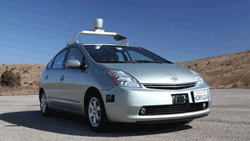Nevada set to begin handing out special license plates to robot cars
Legislative commission approves regulation for operation of robot vehicles on state’s roadways
As of Thursday, tech companies can apply for a new kind of driver’s license in Nevada — one that will allow for the legal testing of self-driving vehicles on the state’s roadways.

Google’s self-driving car (Via: inquisitr.com)
Nevada is the first state to adopt a rule of this kind, but certainly won’t be the last: California, Florida, Oklahoma, and Hawaii are all in line to adopt similar legislation, clearing the path for companies to come in, set up shop, and legally test their new technology.
The legalization process
In June 2011, Governor Brian Sandoval signed “AB511” into law. Without getting into all of the fine print, the law makes it legal for cars to drive themselves in the state of Nevada. But even though the bill was passed, it still required the DMV to establish rules and regulations on how companies could go about applying for permission to get their self-driving automobiles on the road.
Fast forward to this month: the guidelines are written, approved and officially put into place. On March 1st , the Nevada DMV will start handing out red license plates to tech companies that want to test out their robotic cars, just so long as they meet all of the state’s requirements.
Rules of the road
“Nevada is the first state to embrace what is surely the future of automobiles,” Department of Motor Vehicles Director Bruce Breslow said in a press release. “These regulations establish requirements companies must meet to test their vehicles on Nevada’s public roadways as well as requirements for residents to legally operate them in the future.”
To help create the rules, the state department partnered with Google, who has long been semi-legally testing out their robotic Priuses on California and Nevada state roadways, as well as automobile manufacturers, testing professionals, insurance companies, universities, and law enforcement officials. While the group was tasked with making sure they got the legal language right, their main priority was to ensure that testing this technology out in public would in no way put human drivers at risk of danger.
Two major stipulations include:
• Each vehicle requires a $1 million to 3 million bond to insure against damages.
• Companies that test self-driving vehicles out will have to provide the DMV with a detailed report on what they’re testing with each car.
When the cars are approved for production, the tech companies will trade in their red license plates for green ones, meaning the technology is a “go.”
Outlook
Here’s the cool part: Owners will be able to legally operate their vehicles without actually being in the car. This presents tremendous opportunity to make daily errands much easier, including sending the vehicle out to pick up friends and family, scheduling a pick-up at the local food market for groceries ordered online, and much more.
Furthermore, taking people off the road removes the potential for human error. That said, this emerging technology could potentially save thousands of lives lost to traffic incidents every year. ■
Nevada DMV press release via: dmvnv.com/news/12001-regulations-for-self-driving-cars.htm
Reference for article via: singularityhub.com/2012/02/22/starting-march-1st-a-red-license-plate-in-nevada-means-the-driver-is-a-robot
Advertisement
Learn more about Electronic Products Magazine





